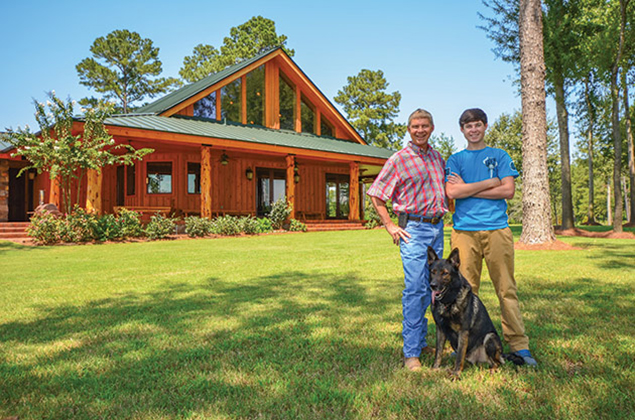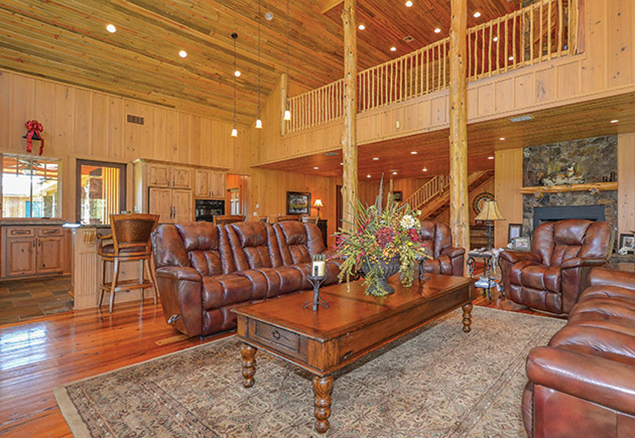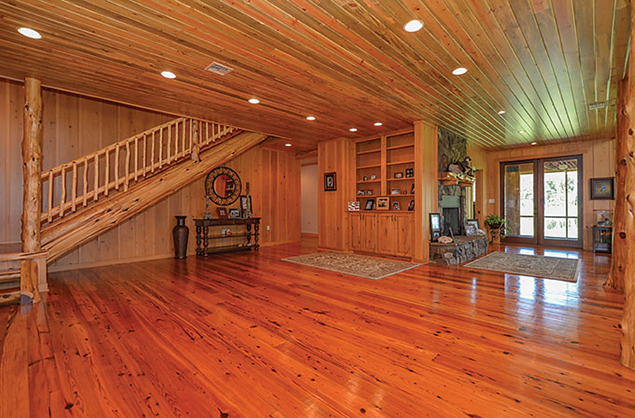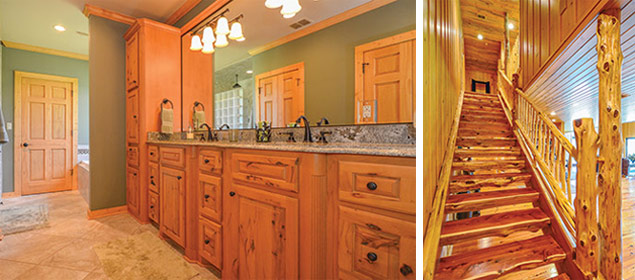After buying several hundred acres in rural Louisiana in 1999, it didn’t take long for Louisiana Land Bank customer Lovic Wren to pick the exact spot where he wanted to build a new house. He could imagine the porch and the ponds, long before they actually existed. And he knew it would feature a variety of woods.
Turning that vision into reality would take longer, much longer, however. Twelve years, to be exact — 11 years to prepare the site and one to build the house. Meticulous and intent on doing much of the work himself, Wren wanted the job done right. “I only wanted to go through this process once,” he explains.

Lovic Wren and his son, Brock, with one of their dogs, Vinnie
Photos by Bram Wilens@The Wooden Shoe LLC
Why So Long?
It turns out that a century ago, someone else had built a house at the same location. Fifty years later, it was abandoned. By the time Wren bought the property, the homesite was a mess of brick fragments, rusty wire, old garbage and impenetrable brush.
Many people would have shied away from a challenge as large as clearing out such a mess. But Wren, always focused on the end goal, tackled the job little by little, with help from his sons and his brother Rusty.
“I’d come out here every day after work, every Saturday, and Sundays after church,” he says. “The boys would jump on their four-wheelers, and I would jump on the tractor and work.”
In 2006, he and his sons, Lovick and Brock, moved out to a mobile home on the property from their home in Shreveport. For another four years, he planned all the details of the house he wanted to build.
“I would put the boys to bed, get in my truck, drive up to a hill overlooking the ponds and just sit there and think,” says Wren, who now supplies oil and gas drilling companies with water from the farm. “I thought about how to get into the water business, what kind of house I wanted to build, what improvements I wanted to do to the property.”
Finally, after more than a decade of clearing brush, trash and trees, the site was ready for a new house. Construction started Aug. 1, 2010, and ended exactly one year later.
The original house plans were hand-sketched by his son, Brock.
“Brock would go to work with me in the summer and would sit in my office with graph paper, and draw out the plans. When we got ready to build, I took the plans to an architect. He asked me who drew them, and I told him my 13-year-old son did,” Wren says.
Why Wood?
“I always knew I wanted a wood house, because wood is a low-maintenance material,” he explains. “We used cedar and cypress, so we should have no problem with rotting wood.”
The house has no gutters, no exterior paint, a lifetime metal roof and an exterior of Arkansas stone.
The house prominently features 11 types of wood. The great room showcases 25-foot-tall cedar columns, heart pine floors rescued from warehouses after Hurricane Katrina, a blue pine ceiling and knotty pine trim around doors and windows. In addition, several other kinds of wood were used behind the scenes.

A blue pine vaulted ceiling soars over the great room, supported by 25-foot-tall cedar posts. Heart pine in the flooring was salvaged from warehouses after Hurricane Katrina.

Light through French doors casts a glow on this view of the great room.
Wren can tell stories about why each wood was chosen and where it came from. He appreciates the unique character of each one, as well as its imperfections. He wonders what stories the woods would tell if they could.
Better Than Imagined
The great room is Wren’s favorite place in the house. From its giant plate-glass windows and French doors, he can view his timber stands in the distance and watch wildlife at play beside the two 4-acre ponds in his front yard.
About 30 mallards live in the ponds, and they are joined seasonally by other duck species “just passing through.” He also enjoys watching bald eagles and osprey that come to fish in the ponds every winter.

Lovic Wren built his home using numerous types of wood, giving the house a warm and inviting atmosphere.
“I love nature and the outdoors, and I thank the Lord every day for this place,” he says. The home is secluded, set off far from the road. “I didn’t build it to be admired. I built it for the boys and me,” he says.
Even he can’t believe that it’s true, sometimes. “My uncle told me that I’d really built my dream home. I told him that I never dreamed of having a house like this.”
TRANSFORMING AN OLD CATTLE FARM
Water and timber provide new income streams
Like many people who buy rural property, Lovic Wren knew when he bought his first 468 acres in 1999 that he wanted to make it home eventually. But with a life and business in the city of Shreveport, La., about 30 miles away, he knew it was going to take some planning, sacrifices and a lot of hard work.
“I had been looking for about 100 acres, and this place was really bigger than I wanted. But I made an offer, and it was accepted,” he says.
The first decision he had to make was what to do with the land. The previous owner had raised cattle on the property.
“I grew up on a farm that had beef cattle and timber, so I had to decide whether to plant trees or raise cows,” he says. At that time, he was co-owner and manager of his family’s bottled-water company in Shreveport. “I knew that I did not have the time to devote to cattle, so I decided to plant trees.”
Planting Trees
With a paper mill about 10 miles away in Mansfield, La., the decision made sense. “The site index is 90 for pine here. That means that the trees will be 90 feet at maturity. This is a big timber region,” Wren says.
He planted 250 acres of pine in pulled beds that he created with a three-way plow. However, some of the acreage was not conducive to growing pine. In low-lying areas, he clear-cut a 50-acre tract and replanted it with hardwoods, such as cherrybark oak, willow oak, water oak and Nuttall oak. In areas that hold water for several months of the year, Wren planted cypress. “Everything we planted is marketable wood,” he comments.
Today he has trees at six different stages on his property, ranging from 12 years old to 1 year old. Wren works closely with a forester to implement his forestry management plan.
“Our goal with the pine is poles and pilings. That’s the most valuable market for pine,” he says. “We plan to thin it when it is 15 years old. Typically with pine, the first thinning is done at 12 years, but we will wait another three years for the potential of growing for poles and pilings.”
Starting His Own Water Business
In 2010, Wren sold his interest in his family’s water company. For years, he had contemplated ways that he could launch a water business of his own.
Finally, he realized his niche: selling water to the oil and gas industry.
“Natural gas was discovered in the area, which resulted in a tremendous need for water,” Wren says. “I had three wells on the property that are used as back-up wells for the City of Mansfield. I paid the city for a tap, so that I could provide processed water for the rig workers to use for things like washing dishes, taking showers and washing their clothes.”
A trucking company would then take the water to the drilling sites. And the Heart of Haynesville Water Company was born.
The next step was to dig a pit and install filling stations. The pit will hold as much as 4 million gallons of water, which can be pumped to 12 filling stations. Water also can be pumped to the stations from the two ponds in his front yard.
Improving the Property
In the 13 years that Wren has owned the property, he has built more than 12 miles of roads. He expects that road work will be an ongoing project.
“I build roads as protection against fire,” he explains. “The roads allow me to plant trees in different blocks, so that if there ever is a fire, hopefully the roads will slow it or stop it before it takes out everything.”
Wren always looks ahead to how he can keep making the land better. “When I leave it to the boys, I want there to be an excellent stand of timber on it,” he says.
-Penny Currie
TIPS FOR BUILDING A COUNTRY HOME
Lovic Wren shares his advice for how to build a dream home in the country.
Save up for your dreams. “I didn’t inherit an acre, so I saved for years for a down payment,” he says.
Plan the home you want. “Think about what you want, envision it,” Wren advises. “I knew I really wanted wide porches overlooking the ponds for one thing.” Today, that porch is where he enjoys his morning coffee.
Wait until you can build what you want. Wren wasn’t interested in the short term; he preferred to wait until he was able to build the home he really wanted.
Don’t think things are beneath you. Wren lived with his boys in a mobile home on the property for years before breaking ground on the home they have now. “Every night we would thank God for a warm home,” Wren says. “We were glad to have that home, but it also helped us decide what we wanted in the next home. For example, I knew we needed a kitchen big enough that we would not be bumping into one another.”
Work hard to make your dream a reality. From the time he purchased his first piece of rural real estate, he knew he wanted to make it home. And he was willing to put in the sweat equity to make it into the home he wanted.
The Right Lender Makes the Difference
When a banker gives advice about banking, people usually listen. That’s how Lovic Wren ended up doing business with Louisiana Land Bank.
“A banker friend told me that that’s who I should go to for a rural property loan,” he says. “The banker has loans with the Federal Land Bank, himself.”
The advice turned out to be a blessing for Wren.
His first loan was to purchase his rural acreage. Since then, his relationship with the Land Bank has helped him to expand his land holdings, build his house and start his business. And he has appreciated the help of his loan officers, David Ogletree and Jon Fielder.
“The Land Bank has been absolutely excellent to work with,” Wren says. “I didn’t feel like they were doing me a favor. I felt more like a partner than a loan recipient.”
TYPES OF WOOD USED IN THE WREN HOUSE
| Type of Wood | Origin | Use/Purpose |
|---|---|---|
| Cypress | Louisiana and Mississippi | Beams, walls, trim |
| Heart pine (reclaimed) | South Louisiana | Floors |
| Ponderosa pine (blue pine) | Pacific Northwest, South Dakota and California | Ceilings and walls |
| Cedar | East and South Texas and British Columbia | Columns, stairs and stair rails; 1x12 wall boards |
| Hickory | Tennessee and Kentucky | Walls and ceiling |
| Rustic beech | Germany | Cabinets |
| Knotty pine | Arkansas | Door trim |
| Fir | Oregon, Idaho and Washington | Framing and trim |
| Yellow pine | Iowa, Idaho and Texas | Decking and framing |
| Clear yellow pine | Louisiana | Ceilings |
| White pine | Washington, Oregon and Canada | Window casing and door trim and inside doors |
| Pine | Louisiana | Floor trusses and subfloor |
| Mahogany | Brazil | Exterior doors |
| Miscellaneous hardwood | Louisiana and Missouri | Molding |
| Oriented strand board (OSB) | Louisiana | Structure |
| Laminate beam | Louisiana | Roof support in great room |